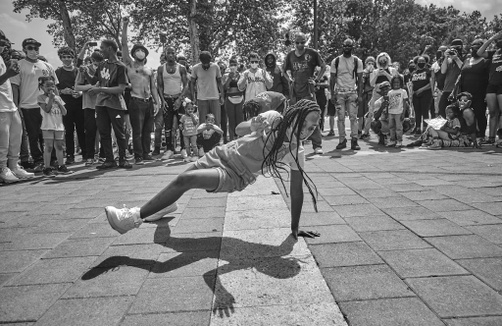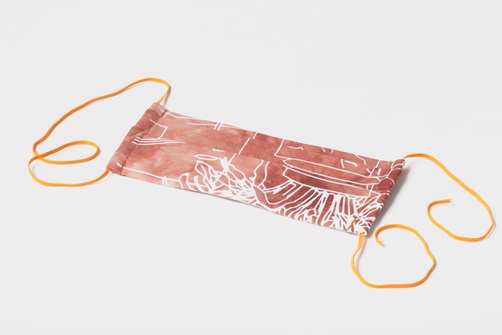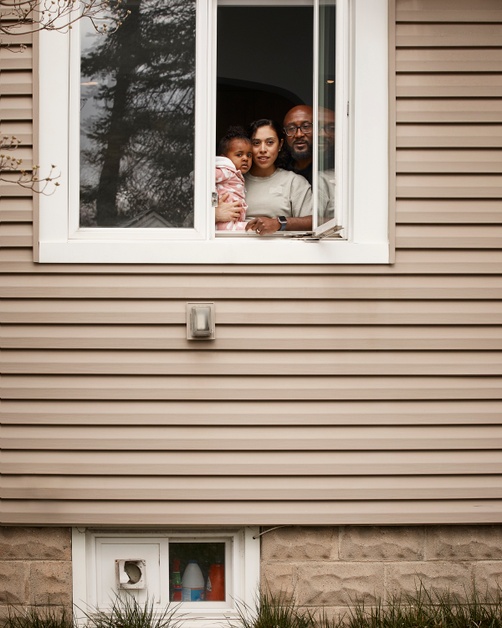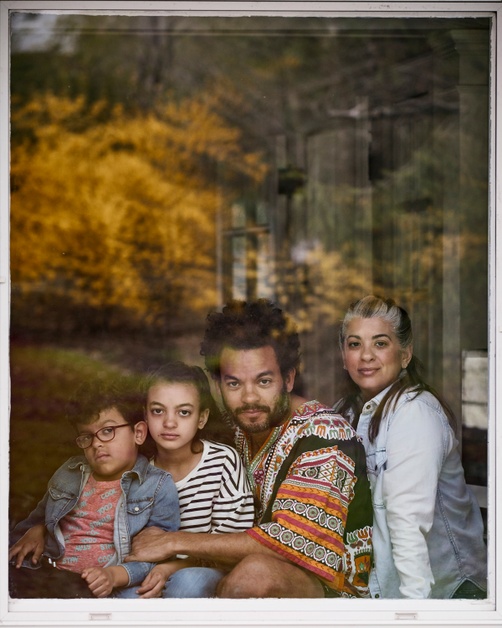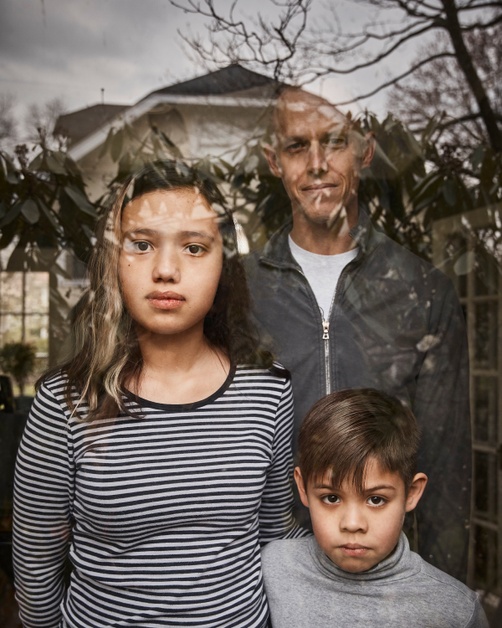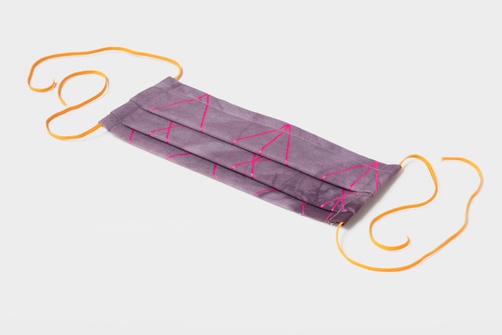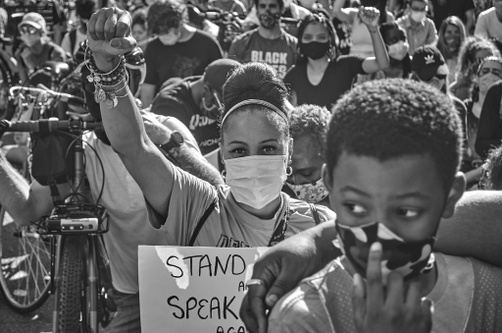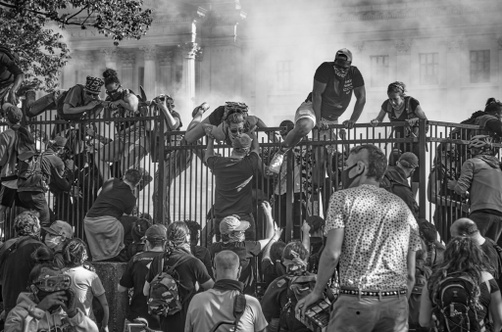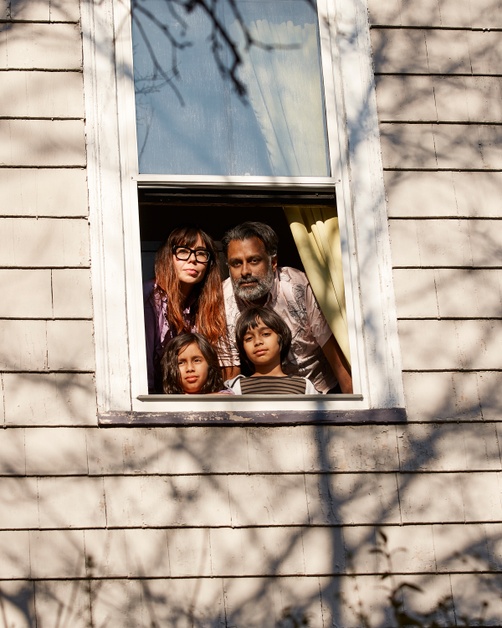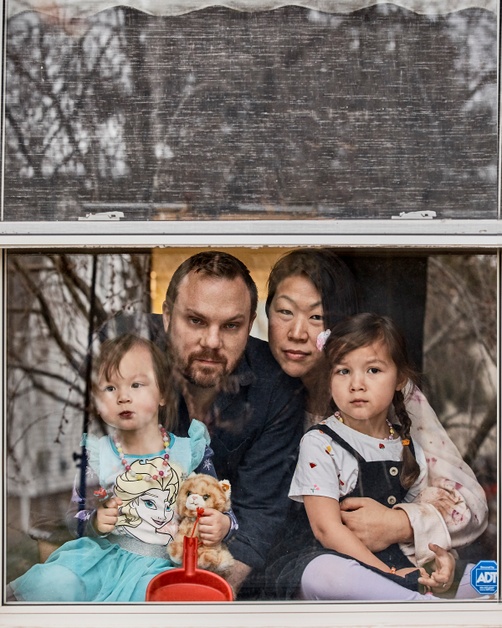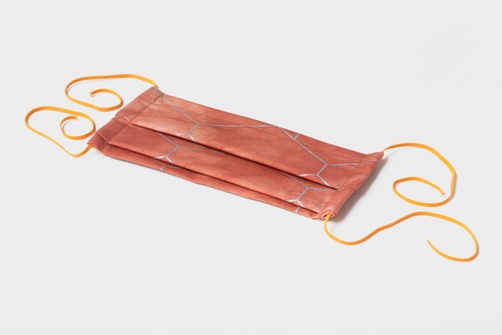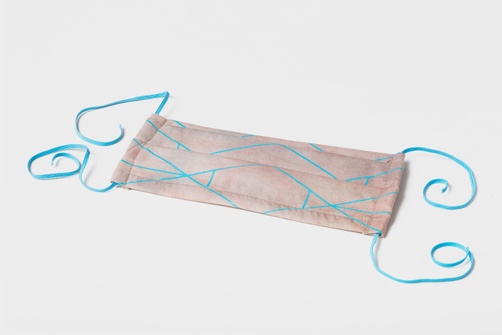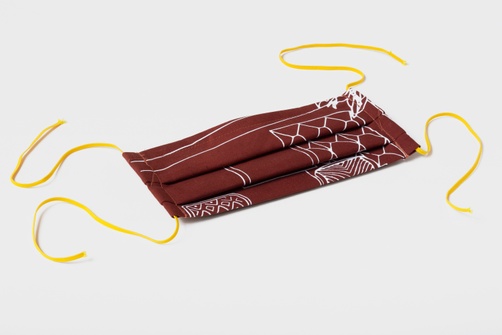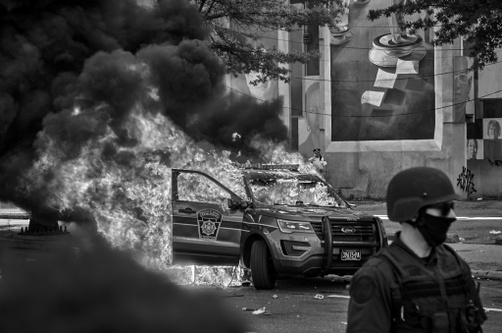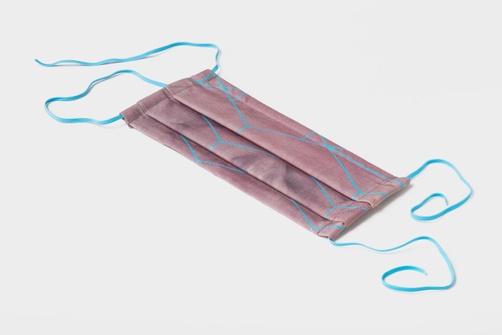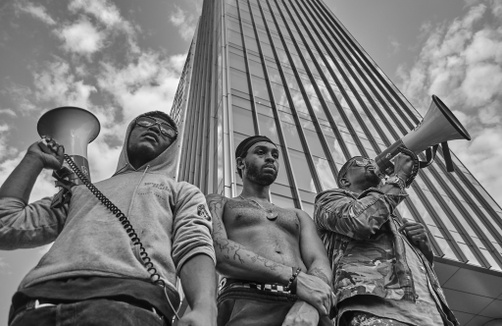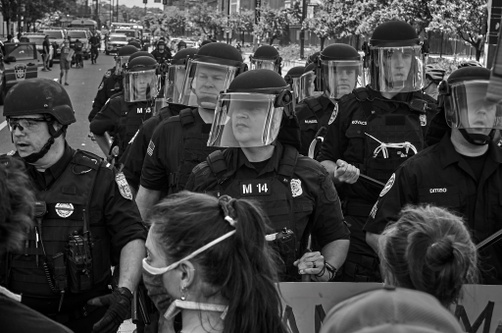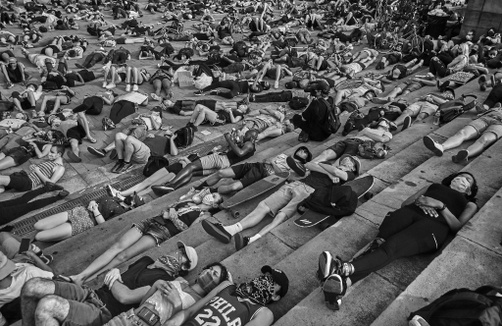Past Exhibitions 2021
Pandemic and Protest









This exhibition features three artist projects made during the spring and summer of 2020—an unprecedented time of an expanding worldwide COVID-19 pandemic and protests across the country calling for racial justice sparked by the murder of George Floyd in Minneapolis, Minnesota. The projects, supported by and acquired by the Tang Teaching Museum, include Isaac Scott’s protest photographs from Philadelphia; Danielle St. Laurent’s portraits of families in quarantine through the windows of their homes; and MASKS4PEOPLE’s silkscreened face masks created in collaboration with sculptor Nicole Cherubini’s installation at the Tang.
Pandemic and Protest includes oral histories with the artists and new writing by Skidmore faculty and staff about the works. We are grateful to all whose words are included here, especially our colleagues who offered their personal reflections on this historic moment.
Additionally, Skidmore students wrote short responses to these projects after meeting with and interviewing the artists in September 2020. It is our hope that this exhibition will demonstrate how we can act to support artists, to document and preserve historic moments as they happen, and to serve as a repository and archive of primary-source material for future study and research.
Ian Berry, Dayton Director, Tang Teaching Museum
Marta Brunner, College Librarian, Scribner Library
Pandemic and Protest is supported by The Andrew W. Mellon Foundation, Jack Shear, and the Friends of the Tang.
The MASKS4PEOPLE project was a Tang commission with funding from David Coleman and Sally Whitman Coleman ’87 and the New York State Council on the Arts.
Special thanks to Tang staff members Sophie Heath, Kara Jefts, Annelise Kelly, Rebecca McNamara, Kelsey Renko, Jean Tschanz-Egger and to Jessica Eisenthal, Art Evans, and Skidmore students in the Fall 2020 The Artist Interview seminar for their important work to help create this online project.
Artists
Skidmore Responses
Rachel Cantave, Assistant Professor of International Affairs
Andy Demaree, Director, Counseling Center
Lisa Grady-Willis, Associate Director of Intergroup Relations
Kelli Johnson, Director, Opportunity Program
Julia Routbort, Associate Dean of Student Affairs for Health and Wellness
The Movement Unmasked
by Lisa Grady-Willis
We Wear the Mask1
By Paul Laurence Dunbar
We wear the mask that grins and lies,
It hides our cheeks and shades our eyes,—
This debt we pay to human guile;
With torn and bleeding hearts we smile,
And mouth with myriad subtleties.Why should the world be over-wise,
In counting all our tears and sighs?
Nay, let them only see us, while
We wear the mask.We smile, but O great Christ, our cries
To thee from tortured souls arise.
We sing, but oh the clay is vile
Beneath our feet, and long the mile;
But let the world dream otherwise,
We wear the mask!
Our masks are wearing thin …
In 1896, poet Paul Laurence Dunbar spoke of wearing the mask—the armor and protection necessary to shield our hearts from the rest of the world. He calls us to reckon with all that the mask represents and all that is hidden underneath. Today, the mask is no longer just a symbol or metaphor—it is also a physical reality donned by many who are unfamiliar with the purpose, power, and pain involved.
Both internal and external debates rage on regarding who, when, and why. Whom does it serve? When is it necessary? And just, why?
There are people deeply committed to the preservation of self, while some put other folks first, seeking to shield those around them from what intimate engagement might bring. Still others recognize preservation of self as a societal gateway beyond individual concerns. They see preservation of self as preservation of homeplace, family, and community. They see themselves as inextricably linked to those around them: individual survival is communal survival. Likewise, collective shifts require individual investment on a foundational level.
The need to breathe is ever-present while the fight to breathe persists—whether on the pavement or in the hospital room. Faces unadorned, we share spaces with those privileged to know what is behind the mask. “Torn and bleeding hearts” revealed—the fear, the frustration, and the pain that we share contributes to our interdependence. We take deep, measured breaths as we move about, behind shut doors, closed windows, and open computers. We are constantly strategizing about the next move and waiting for the next pronouncement. We hold our breath when a seal, a promise of security, is broken. We scramble to gather our thoughts and our things (sanitizer, mask, bullhorn, backpack …). Comfort falls by the wayside—even in our most sacred spaces.
Though die-ins, reenactments, and marches may offer some clarity, symbolic moments of solidarity cannot convey the solitary reality of face pressed to pavement … dignity undone.
I walked into the grocery store on Thursday, May 28, 2020, and was overcome by the reality of the day. Tears flowed slowly over my mask as I moved from aisle to aisle and heard folks exchanging pleasantries. I had stayed up through the night watching as things unfolded and buildings burned. No. I’m not okay. Are you?
Exhibition Name
Exhibition Type
Place
Dates
Curators
Artists

Ian Berry
One of the images you made as a print for the Tang is a sea of people lying flat on the ground, head to toe. What was happening in this moment?
Isaac Scott
This was at the end of a protest during that first week, at the steps of the Philadelphia Museum of Art. It was June 4, and everybody lay down for eight minutes and forty-six seconds as a moment of silence in honor of George Floyd. It was a powerful moment, in part, because eight minutes and forty-six seconds is a long-ass time. It was a really hot day, everybody was tired. The ground was hot. You could see everyone’s discomfort at being on the ground for that long. I think it really hit home for many. Some people stood up crying at the end of it.
IB
There is also a wider view that shows a park filled with people as far as you can see. It looks like you might be standing on the same steps. Was this also that day?
IS
Those are the same steps, but this was on June 6. It was the biggest protest by far that happened in Philly. Over 100,000 people showed up. The march went from the Philadelphia Museum of Art down to City Hall. By the time the protest actually started moving, the crowd stretched the whole way from the PMA to City Hall. I walked through the mass of people to the top of the steps and took this picture.
IB
Why choose Instagram as the way to share these?
IS
If there’s a place for photos, I think Instagram is it. It’s where you get the most eyes on images. My goal was to have a broader context for what’s happening because I feel that what people see in the news is watered down and doesn’t speak to the humanity of the people who are out there.
I wanted to take pictures that reflect the energy of these moments: to humanize and get people to look at the protesters, the leaders, and the organizers a little differently.
IB
Another image in the Tang group is what looks like a potentially violent image of people climbing over a tall iron fence during an altercation. What’s happening here?
IS
This was the second protest I went to, on June 1, and it was another big one with thousands of people. It was a peaceful protest marching through the streets, but once we made it out onto the highway, cops in riot gear with military vehicles emerged. They surrounded us very quickly and started shooting people with rubber bullets, tear gas canisters, and mace. I was toward the back of the march, so I just saw all these people running toward me suddenly, “What’s happening? What’s happening?”
I could start to feel the mace and tear gas in the air, so I made my way off the highway. As I got up onto a grassy embankment, a tear gas canister hit five feet to my left. It was hard to breathe and I started coughing immediately. The tear gas went up my mask, right into my eyes. My lungs were on fire, my face was on fire. I couldn’t see anything as I waded my way through the crowd, until some guy came over and dumped milk on my face.
I tried to collect myself and went down the street and found a scene of people who had gotten trapped on the highway. They were cornered and the cops were shooting rubber bullets and tear gas at them. They were screaming and climbing on top of each other, pushing each other up over the fence. People on the other side were trying to catch them and dump water on their faces. Everybody was shouting and it was just pure chaos. The craziest thing was that no one was fighting back; the cops just started firing at people. On the other side of the fence, they were dragging people down and beating them. It was the most horrific thing I’ve ever seen.

An excerpt from an essay by Cerri Banks, Dean of Students and Vice President for Student Affairs, Skidmore College:
An Open Letter:
Justice. Equality. And to stop being murdered. That is all we ask for. How else do we get your attention? We march. We chant. We shout. For years, you did not believe us, would not believe us.
We TOLD YOU, over and over again that Black and brown people, poor people, trans people, immigrants were being murdered in the streets and in our homes.
We TOLD YOU, over and over again that white supremacy, white privilege, hatred, racism, and unchecked power was rampant in the very institutions that are charged with serving us and protecting us.

An excerpt from an essay by Andrew Demaree, Director of the Counseling Center, Skidmore College:
Isaac Scott’s powerful photograph of protesters lying down on the steps and ground outside the Philadelphia Museum of Art is one of my favorites by the artist. Evoking a mix of reactions, it is an intricate snapshot of a moment in time. My eyes are drawn to explore the countless details: the myriad bodies packed into the space, the protesters’ clothes, the objects they carry, the masks and bandanas with which they have covered their faces, what they’re doing with their hands. As a psychologist, I am also drawn to wonder about their identities, their stories. What can be discerned about their ages, their ethnicities, their gender identities? Beyond that, what are their personal histories and what compelled each of them, individually, to be present for this moment?

An excerpt from an essay by Kelli Johnson, Director, Opportunity Program, Skidmore College:
It is no coincidence I am writing this essay on January 20, 2021. It is no coincidence this photograph by Isaac Scott, which he took on June 6, 2020, what he called “a historic day,” speaks to me in such a powerful way. Both the inauguration of Joseph R. Biden and the photograph express hope and change. The Black Lives Matter (BLM) movement is nothing new. Black folks have been protesting and demonstrating for more than a century. Our very existence in this country was built on policies engrained in systemic racism that has affected every aspect of our lives. That entire premise, of needing to demolish engrained racist policies, is daunting and tiring. Civil disobedience is our cry for help, seemingly the only time our voices are heard. But it is not because we are silent. We are and have been speaking. It just seems our screams are the only thing that other folks will to recognize. Now, with the help of social media and smartphones, our cries are being lifted to new platforms. Folks are listening. They are watching. They are joining. And even in the painstaking work of peaceful demonstration, there are rays of hope. Here, we can see that hope in the break dancing of a young person.
mask, 2020
hand-dyed and screeprinted cotton, interfacing, thread, metal, elastic
Tang commission with funding from David Coleman and Sally Whitman Coleman ’87 and the New York State Council on the Arts
2020.49.4

Ian Berry
How did you start MASKS4PEOPLE?
Laleh Khorramian
In all honesty, I needed something to take my mind off everything. Kristen Dodge wanted masks made for her caregivers, and because I work with textiles and have sewing machines, I figured out some patterns and made them. When COVID-19 really hit, it became a no-brainer: we have the resources and the workforce, let’s make them.
Kristen said, “We’ve got to make them for the essential workers, and we’re going to raise money, and we’re going to do this right.” It was because of her that the organizational part was in place. I was the production lead, and she was everything else. We worked together every day. I was working twelve hours a day at the beginning.
IB
This was in March 2020?
LK
Yeah. It seemed like the right thing to do and something I could do to help. I threw my head down and worked. I remember it being a very emotional time, especially reading the emails from nurses and healthcare workers.
IB
This was all happening at a moment when people weren’t wearing masks, but there was already discussion of a mask shortage. People were stockpiling and donating masks to hospitals.
LK
I remember we had trouble getting elastic and other materials; everybody was suddenly starting to make things because you couldn’t buy them. You couldn’t get an N95 mask, you couldn’t even get those wimpy surgical masks that are everywhere now.

An excerpt from an essay by Julia Routbort, Associate Dean of Student Affairs for Health and Wellness at Skidmore College:
Who do you protect?
We (more women than men in that “we”) made masks because we had to, because there were not enough, because they helped, because we needed to help. We dug out sewing machines, exchanged patterns, watched videos, experimented, ordered supplies, MacGyvered when supplies ran out, and dug into thrift store remnants. We made masks out of old flannel shirts, shop towels, bandannas, and curtains.

An excerpt from an essay by Rachel Cantave, Assistant Professor of International Affairs, Skidmore College:
Political statements printed onto life or death technologies: what better symbol is there for the times in which we live? That was my first thought when viewing the collaboration between Nicole Cherubini and MASKS4PEOPLE.
As an anthropologist, trained to pay attention to symbols, I wondered how these particular masks work and what they communicate. I used to think of masks primarily through their association with religious rituals, funerary rites, and festive ceremonies like the vibrant costumes of a Caribbean carnival. Now, masks seem like a daily reminder of the quotidian and existential precarity of modern life. In other words, masks are protective and rather depressing. However, how does the mask transform when it features the writing of our most compelling activists, scholars, and artists? Can the protective barrier become a bridge?












Ian Berry
March quarantine happens, and everything shuts down. How did that affect your world?
Danielle St. Laurent
It was bad. I didn’t do well in the beginning. I have a constant need to get out of the house, so lockdown was hard for me. I start crumbling if I’m home all the time. Also, I have two kids and it’s always been important to me to have a career and not get too consumed by mom life. Of course, being a mom is so very important to me, but I never wanted it to be everything. I think it’s important for my kids to see that I have this passion and direction.
IB
Were you in New York City at this point?
DSL
No. We had lived in New York for a long time, but about two years ago we moved out of the city to a little commuter suburb called Maplewood, New Jersey. It was something that my husband wanted more than I did. He’s fine with never leaving the living room.
IB
Did the portraits start as a project or did it turn into one?
DSL
At the beginning, there was no goal of it becoming a project; it was just my way of digesting what was happening. I was depressed and needed a place to go, a reason to get up and get dressed. The portraits got me out of the house, got me to put on some mascara and feel like I had a purpose again. March 13 was the day that everyone started getting nervous here, and then within two days people were too scared to go outside. At some point during those early days, I looked out my window and saw a kid looking out of his window and it felt so sad. I started to think and worry about the long-term effects on kids not being able to go out or see their friends. I basically had to rewire my children not to run up to friends or people that they love, which was really difficult. We were all barely going outside, and when we did and would see someone, the impulse became to turn the other way because it felt scary.
IB
How did the first portrait in the series come about?
DSL
I asked my neighbor Claire, who is also a close friend, if I could do a portrait of her family with them inside their house and me outside in their yard. We weren’t even sure we could go into someone’s yard; that early on, nobody really knew anything about how COVID-19 spread. Claire is a photographer, too, so for the shoot we were able to use nonverbal communication: it was a lot of pointing and gesturing while holding the phone. Luckily, their house has a big window that is low to the ground with a lot of trees that reflect beautifully in the glass. It was only when I started editing that I realized that the series is so much about these reflections and the world outside that none of us were experiencing.

